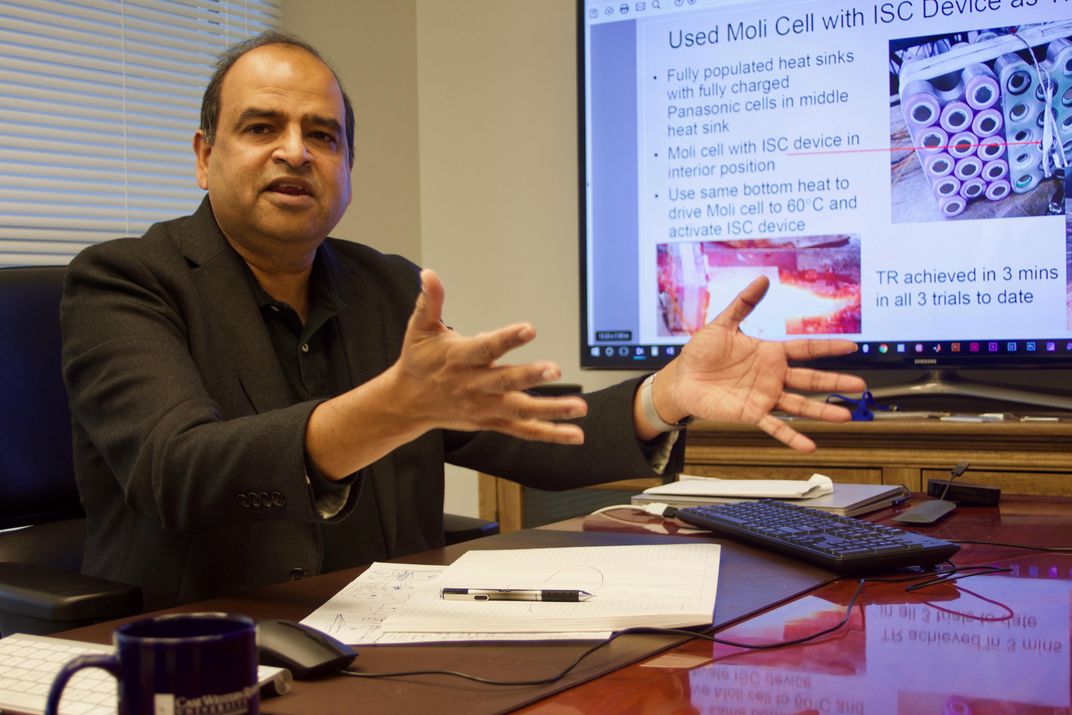It May Take 20 Years, But Your Air Taxi Is On the Way
Vikas Prakash wants to move cab riders off the ground and into the air.
/https://tf-cmsv2-smithsonianmag-media.s3.amazonaws.com/filer/7c/6d/7c6d1054-d0f7-4e93-838a-4f1cf8f34f85/air_taxi.png)
A professor of mechanical and aerospace engineering at Case Western Reserve University with a $1.3 million grant from NASA, Vikas Prakash wants your next taxi ride to be in an electric-powered personal air vehicle. He recently spoke with Air & Space senior associate editor Diane Tedeschi.
Air & Space: What is your definition of an air taxi?
Prakash: A flying vehicle with a range of 50 to 120 miles, carrying two to four passengers, and cruising at an altitude of 3,000 to 5,000 feet. Based on the current battery technology, the most common commute might be a 50-mile round trip with two short vertical takeoffs. The Federal Aviation Administration limits air vehicles flying under 10,000 feet to speeds of about 250 mph, so we could expect speeds between 150 to 200 mph. That could mean getting door to door in three or four times the speed of a conventional road taxi—a pretty attractive upgrade for many people.
Will the air taxis be unmanned?
Yes, air taxis will eventually be unmanned. It may be another 10 to 20 years before we see a fully automated, pilotless aircraft zipping around an urban area. The process will likely evolve [in a way that is] similar to what is taking place with driverless cars today.

What are the advantages of battery-powered propulsion over jet propulsion for air taxis?
For air taxis to serve the on-demand urban transit, they need to be safe, quiet, clean, and efficient. All-electric aircraft, which utilize battery propulsion over jet propulsion, are expected to have zero operational emissions and be quiet enough to operate in cities without disturbing the neighbors. At flying altitude, noise from advanced electric vehicles will be barely audible. Even during takeoff and landing, the noise will be comparable to existing background noise. With conventional jet aircraft, you have two or more large engines under the wings, but these air taxis will have numerous smaller electric motors positioned along the fuselage, enabling distributed energy propulsion.
What do you think is the best design for an air taxi?
We believe the successful air taxi design will not use the rotary-wing design of today’s helicopters. Instead, it will be a fixed-wing craft with vertical-takeoff-and-landing capabilities.
How would your design keep aircraft weight down?
Design engineers face a big hurdle with today’s all-electric aircraft in that the available batteries pack much less energy per unit of weight than jet fuel. The performance gap we need to bridge is huge—about 40 times less [energy than is needed], even if we consider the best batteries available. These energy limitations become especially acute in smaller craft. Electric motors partly compensate for this disadvantage by being more efficient [than jet-fueled propulsion] in converting energy into power, but a considerable gap in performance still remains. The result is that an aircraft would need either a four- or five-time improvement in specific energy density or it would need to carry a very heavy battery pack to approach the performance of current airliners.
In our laboratory, we are exploring non-traditional approaches to address the problem. By replacing some of the conventional materials of the aircraft structure with active battery materials, we can add energy while also saving on mass and volume. We can either use the structure of the airplane to store energy or build batteries that can also serve a structural [aerodynamic] function.
Do you think the public is ready to fly aboard an air taxi with no pilot?
Human pilots are more prone to mishaps than an artificial intelligence operator. However, in a recent poll, more than half the people polled responded that they wouldn’t buy a pilotless flight ticket even if it was cheaper than the alternative. It is important to first familiarize the public with commercial self-piloting crafts starting with autonomous cargo planes, which could demonstrate how the systems can safely fly from point A to B. The next step is to remove pilots gradually, shifting from a two-person cockpit to one person monitoring the system before phasing out humans entirely.
Can our current air traffic control system accommodate air taxis?
Urban airspace is open for business today, and with air traffic control systems exactly as they are, a vertical-takeoff-and-landing service could be launched and even scaled to possibly hundreds of vehicles. A successful, optimized on-demand urban VTOL operation, however, will necessitate a significantly higher frequency and density of vehicles operating over metropolitan areas simultaneously. Air traffic control is going have to evolve, and new ATC systems will be needed to handle these extra vehicles, especially if a city were to add multiple hubs and potentially hundreds of air taxis.
We do not envision air taxis flying in the same space as commercial airliners. A separate air space corridor for air taxis will probably be created. Air taxis could be managed through a server-request-like system that can de-conflict the global traffic, while allowing UAVs and VTOLs to self-separate any potential local conflicts with visual flight rules, even in inclement weather.
